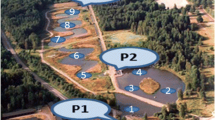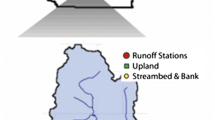Abstract
The landscape structure of a multipond system, runoff type andP-pollutant transport in an experimental watershed was studiedduring 1995 and 1998. A multipond system is a wetland system composed with many tiny ponds and ditches. In this watershed, it was found that such a system effectively controls the hydrological process through its huge storage capacity. The multipond system has a high interaction of land/water ecotones,which decreases the flow velocity systematically and results ina high sedimentation of the particulate matters.The multipond system intercepts runoff and creates either continuous or discontinuous flow. The retention efficiency of the system was very high in both cases but differed in nature. During continuous runoff on 1 May 1998, in a subwatershed Baojiatang, the retention rates of water, total phosphorus (TP),dissolved phosphorus (DP) and suspended solids (SS) by the multipond system were 83.0, 93.9, 90.9 and 94.9%, respectively.During discontinuous runoff on 29 June 1998, runoff volume generated from all lands was 1841 m3, but no surface waterwas exported and the system retention rates of TP, DP and SS were nearly complete. The removal of particulate phosphorus bythe system was more effective than removal of DP and thus DP wasthe main form of phosphorus exported from the watershed duringcontinuous flow. Because of such control, the export amount ofphosphorus was greatly reduced. The output of TP and DP was 0.013 and 0.012 kg ha-1, respectively, from Liuchahe watershed in 1995, and they were 0.037 and 0.030 kg ha-1 in 1998 correspondingly.
Similar content being viewed by others
References
American Public Health Association (APHA) (eds): 1985, Standard Methods for the Examination of Water and Wastewater, American Public Health Association, Washington, DC.
Brix, H.: 1994, Wat. Sci. Tech. 29, 71.
Caraco, N. F.: 1993, TREE 8, 51.
Correll, D. L.: 1998, J. Environ. Qual. 27, 261.
Daniel, T. C., Sharpley, A. N. and Lemunyon, J. L.: 1998, J. Environ. Qual. 27, 251.
De Wit, M.: 1999, Nutrient Fluxes in the Rhine and Elbe Basins, Faculteit Ruimtelijke Wetenschappen, Universiteit Utrecht, 19 pp.
Ebina, J., Tsutsui, T. and Shirai, T.: 1983, Water Res. 17, 1721.
Ellis, C. and Stefan, H. G.: 1986, Water Resour. Res. 22, 1480.
Gburek, W. J. and Sharpley, A. N.: 1998, J. Environ. Qual. 27, 267.
Grant, R., Laubel, A., Kronvang, B., Andersen, H. E. and Svendsen, L. M.: 1996. Wat. Res. 30, 2633.
Haveren, H. P. V.: 1986, Water Resour. Bull. 22, 399.
Horton, R. E.: 1936, 'Surface Runoff Control', in Headwaters Control and Use, U.S. Government Printing Office, Washington, D.C., pp. 166–170.
Jin, W. G. and Yin, C. Q.: 1992, J. Environ. Science (China) 4, 95.
Jin, X. C.: 1995, Chinese Lake Environment (Second), Ocean Press, Beijing, pp. 108–190.
Kronvang, B.: 1992, Wat. Res. 26, 1347.
Naiman, R. J., Decamps, H. and Fournier, F.: 1989, The Role of Land/Inland Water Ecotones in Land-scape Management and Restoration: A Proposal for Collaborative Research 93, MAB Digest 4, UNESCO, Paris.
Novotny, V. and Olem, V.: 1994, Water Quality: Prevention, Identification and Management of Diffuse Pollution, Van Nostrand Reinhold Co., New York.
Novotny, V. and Chesters, G.: 1981, Handbook of Nonpoint Pollution: Sources and Management, Van Nostrand Reinhold Company, New York.
Pionke, H. B., Gburek, W. J., Sharpley, A. N. and Schnabel, R. R.: 1996, Water Resour. Res. 32, 1795.
Schindler, D. W.: 1977, Science 195, 260.
Shan, B. Q.: 2000, 'Phosphorus Transport and Energy Flow in the Landscape with the Multipond Systems', Dr. Thesis, Research Center for Eco-environmental Sciences, Chinese Academy of Sciences, Beijing, China.
Sharpley, A.: 1995, J. Environ. Qual. 24, 947.
Shu, J., Huang, W. and Wu, Y.: 1996, J. Lake Sciences (China) 8, 193.
Sims, J. T., Simard, R. R. and Joern, B. C.: 1998, J. Environ. Qual. 27, 277.
Tu, Q. Y., Gu, D. X., Yin, C. Q., Xu, Z. R. and Han, J. Z.: 1990, Chaohu Lake Eutrophication Study (China), University Press of Science and Technology of China, Hefei, China.
Vollenweider, R. A.: 1992, The Science of the Total Environment (Supplement: Marine Coastal Eutrophication), 1 pp.
Yan, W. J., Yin, C. Q. and Tang, H. X.: 1998, J. Environ. Qual. 27, 1009.
Yin, C. Q. and Bernhardt, H.: 1992, J. Environ. Sci. (China) 4, 5.
Yin, C. Q., Zhao, M., Jin, W. G. and Lan, Z. W.: 1993, Hydrobiologia 251, 321.
Yin, C. Q. and Shan, B. Q.: 2001, Ambio 30, 369.
Author information
Authors and Affiliations
Corresponding author
Rights and permissions
About this article
Cite this article
Shan, B., Yin, C. & Li, G. Transport and Retention of Phosphorus Pollutants in the Landscape with a Traditional, Multipond System. Water, Air, & Soil Pollution 139, 15–34 (2002). https://doi.org/10.1023/A:1015886316782
Issue Date:
DOI: https://doi.org/10.1023/A:1015886316782




